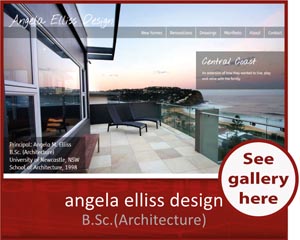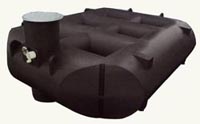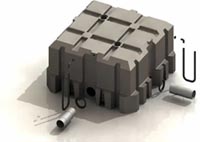Environmental design, green building and sustainable architecture
The terms "environmental design", "green home design" and "sustainable architecture" are just a few of the terms that people use when trying to describe a home that is designed to minimise it's impact on the natural environment. In this article we use the term "environmental design".
Good environmental design positively effects the thermal comfort of a building allowing the occupants to be comfortably warm in winter and cool in summer - with minimal energy usage.
There are 6 main areas that need to be considered when planning your eco friendly house or renovation. The information given in this article applies to sites at a latitude of approximately 32°, which covers the greater Sydney area in NSW, including Newcastle and Wollongong, and Perth, in Western Australia.
Design
Ideally you should purchase a site that is flat and has its backyard facing north towards your view. This will make designing an environmentally friendly house or passive solar home much easier.
Sun and orientation
You will need to spend a good amount of time assessing direct sun penetration onto your site before you start designing your passive solar home. If it were practical, and you oriented all the internal spaces in your home to north, it would be relatively straightforward to build a green home that was thermally comfortable all year round. However in the non-ideal "real-world" this is rarely possible. A great book to use when planning around sun and shade for you building is "Sunshine and Shade", written by R. O. Philips of the CSIRO. Use the basic rules listed in this book to aid you when planning the various spaces in your home.
Sun control devices
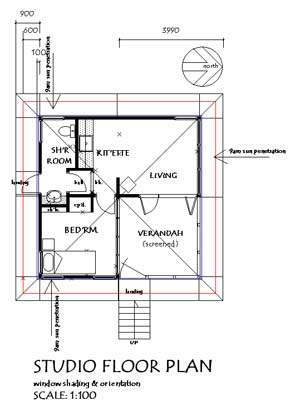
There are many methods of controlling sun penetration in your home helping a house stay cool in summer and warm in winter.
Roof overhangs: For homes that are drenched in full sun ensure that all windows have a standard window and door shading depth of 900mm. 600mm is the normal project home depth and that is not enough. This depth can be slightly altered depending on the orientation of the external walls to north.
Other control devices: If you have no choice in how you orient your living areas, and are forced, for example, to orient them towards the west (the harshest of all options) you will need to get creative. One solution is to plant deciduous trees to the west about ten metres from your house. This will block hot afternoon summer sun and allow winter afternoon sun to penetrate through to your home. If this is not an option due to views or council regulations, the best solution is an operable (adjustable) window device like an awning or louvre system.
Room orientation
If you have shading on your site you need to think about the room type and design to get the optimum sun penetration into the space; e.g., locate laundries, bathrooms and storerooms to the west or south. These rooms can be physically cut off to control the hot western sun or the cold resulting from a southern facing orientation. Bedrooms work best located on the east because most people love being or drenched in morning sunlight. (However a southern orientation is a worth considering for shift workers, because the bedroom will then be darker.) Leave the north to living areas as people spend most of the daytime in these areas.
Insulation
To save on heating and cooling costs in your new green home it is essential that all your external walls and ceilings are insulated. All cladding types have an R-value, the higher the R-value the longer it will take for the outside temperature to enter you home.
Many houses today are timber framed and without any extra insulation these homes will not be hot and cold in the wrong seasons but it will also rate poorly with BASIX (BASIX is the Building Sustainability Index.). There are too many products to name, but insulation generally come in the form of "batts", air cell blankets (like bubble wrap), loose pulp, and "sheets". Heat is lost primarily through the ceiling of a home, then the walls and windows, and lastly the floors. If your site faces a windy direction, and is located at the top of a hill, your floors will need to be insulated.
Sarking is a reflective fabric that reflects heat away from the roof and external walls and it should be laid with the reflective side facing outwards. Roof sarking often forms part of an insulative blanket that is laid on top of the roof trusses and under the roof battens.
There are many new products on the market that are a "sandwich" format product (cladding on one side, a finished lining on the other, and insulation in the centre).
Thermal massing
There are various building claddings that have naturally occurring thermal benefits. Products such as core filled concrete block work, double brick, mud brick or hay bales offer internal spaces warmth in winter and coolness in summer due to the thickness of the product and the time it takes for heat of cold to penetrate these products. Core filled block work, double brick, mud brick and sandstone, for example, have the ability to draw the relatively constant temperature of the ground through a building.

Windows and doors
If your sustainable house has been designed using the items suggested in this article, and your windows and doors are not too large, you will not require anything more than standard single glazing throughout your home. Glazed windows and doors are both referred to as windows in the glazing industry. Below is a list of a few basic types that you need to be aware of:
- Single glazed with a standard aluminium frame
- Single glazed with an improved aluminium frame
- Single glazed with a timber frame
- Single glazed with an energy efficient film and a standard aluminium frame
The size and location of your windows are also very important.
Use the following general rules to reduce winter heat escape and summer sun penetration:
- Place small windows on western facing walls to reduce summer sun penetration
- Put large windows on the north side of the house
- Put medium to large windows on the east of the house
- Small windows should be on the south side of the house to reduce the amount of heat that escapes in winter
- Only use skylights where absolutely necessary. Skylights are usually required as the result of poor design.
Colours
House colours and temperatures work much like coloured clothing. A dark brown T-shirt attracts heat and is much hotter on a summer day than a white T-shirt, and your house is exactly the same, especially the roof. Within the online BASIX system if you choose a light coloured roof you will get a better energy score as a light coloured roof reflects the heat better.
Air locks
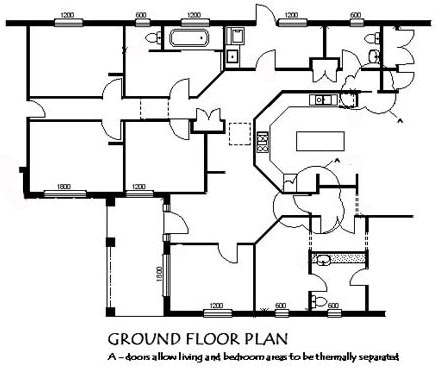
The dwelling design should include air locks so spaces can be thermally cut off from one another. (But you can still have your open plan living space.)
Sub-floor construction
The space under your house is called a sub-floor and correct subfloor construction is very important in keeping energy costs down in your house.
Don't allow air to flow too freely under your house as this increases your energy requirements for heating and cool. If the building is sitting on brick piers ensure that sub-floor perimeter is clad: the better clad this area is, the lower the energy requirements.
A concrete slab that is laid directly on ground is the most energy efficient subfloor because the slab draws on the relatively constant temperature of the ground and radiates that temperature into the house.
Roof shape & construction
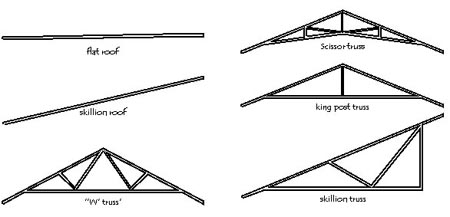
The shape of your roof will greatly help you control the temperature of internal spaces within your eco friendly house and where possible have large roof cavities that a truss can provide.
Where a skillion or flat roof is unavoidable insulate with R5 insulation.
Many new homes don't have roof ventilation. Roof vents remove excess heat from the roof space preventing hot air in the roof radiating through the ceiling. Roof venting will also reduce mechanical cooling and heating requirements.
Related Article How to make your home warm and cosy in winter
Wastage
Whenever possible you should always think about wastage of building materials. Many house designers work to 600 and 900mm increments in room sizes etc as most building materials are manufactured in increments of these.
Any wastage during construction can be used on site especially concrete and bricks, these can be used for fill.
If you are demolishing a building the windows and doors can be sent to a recycle yard as can timber framing and flooring and various fittings. Any concrete, tiles, masonry or brick can be recycling for future use as road base, there are companies that will take the materials for free and you save on expensive tip fees and reduced land fill.
Energy efficiency
When you are in the throws of construction and you are handing out money everywhere it is difficult to allow extra money for the long term energy efficient items.
Lighting
It always happens, the home is almost completed and the budget has been blown, the last things to be fitted are the electrical appliances and fittings... how unfortunate. So quite often the cheapest fittings are chosen, but unfortunately they are also the least energy efficient. Spend the extra money at this time and invest in future energy savings.
Hot water systems
The energy required to heat a regular electric hot water system accounts for 60% of the total household energy requirements. Hot water systems vary greatly in efficiency, price and capacity but generally a gas-boosted solar system is the most energy efficient hot water system.
Appliances
Energy efficient appliances also seem to be more expense when initially purchased. But before you go down that path see www.energyrating.gov.au for a run down on how to choose your energy efficient appliance, and save money over the long term.
Curtains
Any kind of curtain that provides a good air pocket between internal spaces and your window will definitely save you energy. Blinds may look better in certain situations and reduce power bills a little, but blinds do not offer the same ability to cover a window as curtains.
Embodied energy
Embodied energy is the energy used to produce a product from beginning to end. In this section of this article we examine the embodied energy of common building materials.
Take a look at the list below which outlines the embodied energy measured in kiloWatt-hours (kWh) per tonne that is required to manufacture common building products, from least efficient to most efficient.
| 1. | Plastics | 2224 |
| 2. | Steel | 834 |
| 3. | Paint | 667 |
| 4. | Glass | 528 |
| 5. | Mineral fibres | 528 |
| 6. | Bitumen | 278 |
| 7. | Softwood | 144 |
| 8. | Cement | 130 |
| 9. | Gypsum | 100 |
| 10. | Bricks | 60 |
| 11. | Concrete | 11 |
So as a general rule remember that natural building products require less energy to produced than man made products, and use recycled products where possible. Embodied energy is a huge subject but it is an aspect of the energy efficient building process that is missed by many designers. Keep in mind that one of the most energy intensive products to use in construction is concrete, and the most economical is timber, so use plantation timber every chance you get.
Water efficiency
Rainwater and storm water tanks
Most councils in Australia now require that all new residential single dwellings commit to installing a minimum 5,000 litre rainwater tank and many will also require an extra storm water tank to capture overflow from rainwater tanks and hard paved areas. There are now non-obtrusive underground, sub-floor bladder and in-slab options.
Water efficient fittings
There are many fittings that comply with the minimum 3A compliance requirement for wet area fittings, there are even 5A rated products.
BASIX
Since July 2004 developers in NSW has been using the online BASIX system to calculate whether their new home or renovation complies with government standards for energy and water consumption. The programme commits the owner to using less energy and storing more water for use not only in the garden but for toilets and laundries as well.
Getting your standard house to comply with BASIX minimum energy and water requirements.
- Commit to install 80% of your light fitting with dedicated LED or fluorescent fittings.
- Install a 5,000 litre rain water tank for an average size property.
- Have 900mm window and door overhangs.
- Commit to the maximum R-value insulation in all external walls and ceilings.
- Be realistic about window and door sizes.
- Don't have a pool or central air conditioning.
- Truss roof and slab on ground.
Every property and situation is different so the only way to see if your building will comply is to put it through the BASIX system; it's free and you can use it as many times as you like.
Note: Your BASIX commitments will be checked by the building-certifier authorised to perform the final inspection of your new home. If your commitments do not match what the certifier finds you will not be given your final occupation certificate.
Eco friendly materials and pollution
This is where many energy efficient and sustainable products come unstuck. The by-products created as a result of manufacturing building products are often toxic and these products can release harmful chemicals during their life time.
Some examples are arsenic in treated pine, mercury in compact fluorescent bulbs, and various toxic by-products from PVC. For more information on toxic building products see:
Conclusion
In short, designing and building an environmentally friendly home is a tricky juggling act. A great deal of research needs to be done, but for many people it is worth the effort to ensure that your family is living in a non-toxic, energy efficient and healthy home.

